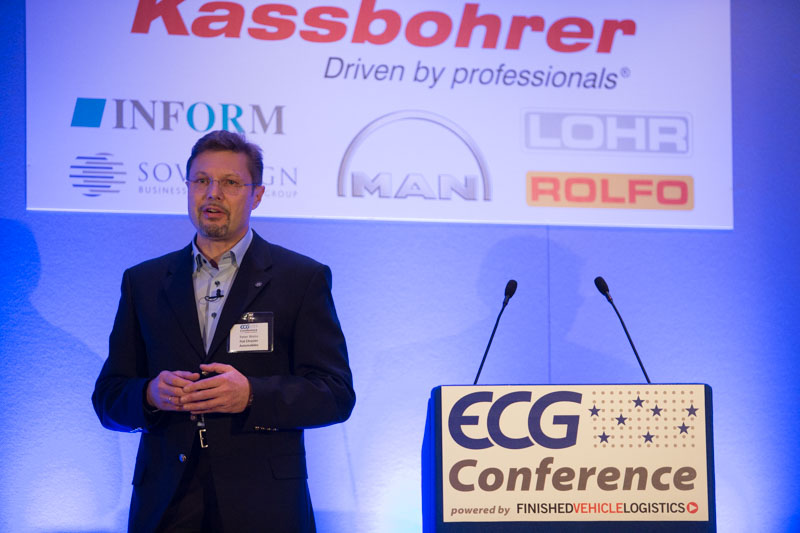
For fans of the comedy sci-fi trilogy ‘Back to the Future’, this October is significant. When the film’s protagonist, Marty McFly, travels 30 years in the future, it is to the date October 21st 2015, where he encounters a world of flying cars, hover boards, self-tying shoelaces and 3D-hologram advertising campaigns.
Many commentators have taken to comparing what the film depicted versus what has come true, with vehicles and communications at the centre of these predictions. Toyota will even release a YouTube video on the 21st in which the film’s actors discuss it. For example, the film anticipated video conferencing and drones, but the flying cars and the ubiquitous use of fax machines turned out to be a 1980s’ view of technological advances. There isn’t much by way of mobile phones, while cars themselves seem to be powered by jet fuel rather than anything even remotely renewable or energy-efficient.
Jump to these sections of the report:
- A healthy market outlook
- Outbound is not back to the future
- Transport policy for the future
- Autonomous examples at Audi
- Sensor technology for railways
- An action list for cooperation
Check back here for more news from the ECG Conference in Vienna
‘Back to the Future’ and preparing for the journey ahead was also the theme of this year’s ECG Conference, held in Vienna, Austria and organised by Finished Vehicle Logistics, prompting speakers and delegates to reflect on developments in their own sector at a time when the European market is seeing a more robust recovery in vehicle sales, and the automotive industry is in the midst of dramatic technological changes. The integration of internet technology and sensors along with driverless vehicles may eventually represent as big a change for the motor and logistics industries as any soaring vehicle would. But that is still in the future – in the present day, the sector is facing capacity and service issues that would be nearly as familiar to executives in 2015 as they would have been in 1985.
The market moves forward to the past
European sales have in some ways begun to move ‘back to the future’. Light vehicle sales across the European Union and EFTA are up nearly 9% in the first nine months of the year compared to 2014, including 10% growth in September. There have been gains across almost all markets, with the UK a notable standout, while Italy and Spain have also enjoyed strong double-digit growth. Philippe Funda, EU and MEA senior analyst at PwC Autofacts predicted that 2015 would finish the year above 14m units, compared to 13m last year – a growth rate expected to outpace all other major regions in the world this year.
With the exception of the UK, however, most western European markets remain below their pre-crisis peaks. While PwC forecasts the market to rise steadily for the rest of the decade, it will only surpass its 2007 peak of 16m units by 2021 – while some markets may remain below earlier highs. To that extent, European vehicle sales might be going back to the future, but it is a future that resembles the volume of a decade ago or more.
Light vehicle assembly and exports, meanwhile, have been and remain strong; assembly is expected to rise 7% this year to 18m units, and approach 19.5m units towards the end of the decade as carmakers including Fiat Chrysler, Renault Nissan and Jaguar Land Rover localise or increase assembly in Europe. “Many people said forget about Europe during the crisis and to focus on China and the BRICs instead,” said Funda. “But a focus only on the growth markets is the wrong strategic decision.”

Outbound still stuck in the past?
With rising sales and output, the vehicle logistics industry should be enjoying its own return to a brighter future. Low fuel prices and interest rates should also be helping the sector to grow and invest with stability. Most executives from the sector are experiencing and anticipate more steady growth. ECG’s latest quarterly survey revealed a big increase in the number of companies reporting rising volumes and increased fleet utilisation, according to Wolfgang Göbel, head of logistics at Germany’s Horst Mosolf, and vice-president of ECG. The survey also revealed that almost 100% of ECG members expected either stable or growing volume over the next six months.
But the waters are somewhat muddier than this clarity of expectation might suggest. Firstly, the European economy faces many risks, any of which could threaten recovery. To name just a few: continued financial and debt problems in the Eurozone; the conflicts in the Middle East and the refugee crisis flowing into Turkey and the EU; the chance that Britain might leave the EU; the depressed Russian market; a weakening Chinese market and uncertain fallout from the Volkswagen diesel scandal. Climate change and related regulations also raise questions about equipment and future costs.
More distant but nevertheless existential threats could also come from the impacts that changing technology and urbanisation might have on the industry. More trucks and vehicles could be restricted from cities, while drivers in some regions might abandon the idea of car ownership altogether. A new wave of automation could upend some of the functions of the logistics industry today as well.
However, for now at least, most European logistics executives are more worried about a consistent shortage of capacity and service levels following years of declining volume, low rates and a lack of investment. “Since the crisis in 2008, investment has fallen, fleets have been reduced and the age of transport assets has increased,” said Göbel.
According to data compiled by car transporter manufacturers Lohr, Rolfo and Kässbohrer, the transporter fleet across major EU markets has fallen from 20,600 units in 2008 to 16,650 as of 2014, with declines across the top volume western European markets with the exception of the UK. Data from ECG surveys also reveals that the number of rail wagons owned across 15 member companies since 2008 fell from 8,880 wagons to 8,265 over the past six years, while the number of subcontracted wagons fell from more than 1,900 to around 500 units.
Göbel pointed to poor investment in rail wagons especially as a “ticking time bomb” as the industry otherwise tries to increase multimodal transport and as vehicle dimensions continue to change, including the growth of SUVs and crossovers. A lack of adequate rail equipment could be a big drawback in efforts to reduce emissions but also to adapt to carmakers’ changing requirements.
The data puts into numbers what many executives from carmakers and logistics provider would attest to in 2015, which has been a noticeable capacity shortage across all of 2015.

“We are all very conscious of the capacity issues and recognise that output from OEMs is variable,” added Gareth Williams, head of distribution for Jaguar Land Rover. “It’s worrying that investment hasn’t been there [in the vehicle logistics market] and that there aren’t enough trucks.”
Chris Godfrey, general manager of outbound engineering for Alliance Logistics Europe at Renault Nissan, also admitted that the carmaker had been dealing with significant capacity issues this year, particularly in the UK, where growth has been brisk. The country’s two annual registration periods in March and September tend to drive a hugely uneven demand that requires bringing in foreign-registered car transporters to meet demand.
“We took an unusual step this year and did a direct contract of 53 trucks at peak time, effectively running them like our own trucking fleet rather than through providers,” said Godfrey. “A lot of that capacity was from the continent. Sometimes you have to think differently to solve a problem.”

Baldissara predicted that smaller companies would continue to die out, while vehicle lead times and delivery quality would suffer. For providers, he warned that a failure or inability to invest would lead more carmakers to rely on solutions such as those Godfrey described, in which OEMs could themselves invest in transport assets or take greater control over the process. He pointed to FCA’s in-house trucking fleet in Italy, i-Fast, or Ford’s fleet in the UK as examples where carmakers showed that they could be competition for providers.
The way out, he maintained, was to work together, share and develop standards – and to invest. Otherwise, the sector wouldn’t gain from growth, or be able to take advantage of future opportunities to their full extent, such as the prospect of a free trade deal between the US and EU.
“We estimate that European vehicle logistics needs €2.5 billion ($2.8 billion) in trucks and compounds, and that is just to reboot,” Baldissara said. “OEMs and logistics providers will have to work together to rebuild the sector.”
Not harnessing technology together
Besides the capacity issue, there was a feeling that the sector is not quite moving back to the future in areas of technology, either. With the automotive industry investing heavily in connected and mobile technologies, including integration with smartphones and increasing driver automation, one might expect the vehicle logistics industry to be moving down the same path. However, executives questioned whether the sector was keeping pace with other parts of the automotive or logistics sectors.

Didier Nulens, global sales, marketing and operations leader for telematics-provider Transics, pointed out that for much of the wider trucking sector, the use of connected technology like telematics was still in the future. Only around 15% of trucks are using a telematics-related fleet management system, while just 6% of trailers are equipped for this, and only 3% of fleets are using remote diagnostics like tyre pressure monitoring. The usage of such technology for the vehicle logistics fleet itself seems likely to be even lower.
However, the potential for such systems is enormous, Nulens said. With most new trucks equipped with many sensors, there will be more opportunities to harness such systems.
There are also examples of carmakers looking towards the sensor and connected features of their own vehicles to improve distribution tracking, including the likes of JLR and BMW. However, Gareth Williams pointed out that even where carmakers and logistics providers were making interesting advances in using new technologies, many were doing so in isolation, risking a continuing proliferation of standards and systems.
“We’re all working on technology, whether it is connected cars with geo-fencing that can update systems or in-vehicle technology. We at JLR are doing something, Audi, Ford, BMW are all doing their thing, too. And logistics suppliers are saying they’re innovating,” he said. “But what we’re not doing is putting it together and utilising the technology to harness and standardise it."

Making policy fit for modern technology
While the conference revealed that European vehicle logistics had not yet arrived at the future it would have hoped for, it nevertheless revealed promising signs of providers and carmakers making better use of technology, as well as a stronger willingness among executives to find common solutions for the sector.
In the path towards connected vehicles and driverless vehicles, officials discussed how government and industry are working to establish new standards and regulations that could transform logistics. Franz Schwammenhöfer, head of Austria’s Department for Integrated Transport and the commissioner for logistics policy at the Federal Ministry for Transport Innovation and Technology, described how the Austrian authorities were looking at shaping policy not only around vehicle-to-vehicle technology, but also for vehicles that could communicate to infrastructure, other objects and transport modes.
Austria is currently working on a series of pilots to help facilitate driverless vehicles and intelligent transport systems (ITS), with legislation expected to start being deployed as early as 2017. One of the keys would be to make sure that different transport modes and services would be integrated.

He said that the freight and logistics sector was needed as a “major catalyst” for determining the right regulatory framework for such technologies both in individual countries like Austria and in building compatible networks across Europe. Schwammenhöfer admitted that policymakers had made big mistakes in the past when it came to poor integration of transport. He also noted that the current technology was changing so fast that governments risked being out of date by the time of implementation. To that end, industry and operators had big roles to play.
“We now have to make sure that we don’t repeat those and that we work together on these very complex changes,” he said.
Walter Nissler, chief of vehicle regulations and transport innovations at the United Nations Economic Commission for Europe (UNECE), also revealed many projects under review in areas of ITS and smarter transport networks at an international level, which include determining common definitions, facilitating interoperability, ensuring data security and connecting with rail transport.
In particular, Nissler sees ITS as an important means for facing the challenges of increasing urbanisation and mega-cities, reducing road accidents, as well as for reducing emissions and addressing climate change. Policymakers and business would have to come up with solutions that might address the shortage of resources for transport, such as the removal of certain elements of private transport in major cities or infrastructure points.
“By application of ITS, we want to respond to these changes for global society, academia and businesses,” he said. “For example, we see door-to-door mobility as a new concept where we combine modes of transport that might start with small autonomous vehicles that bring you to public transport, such as to the airport, where there is no longer parking available.”
While Nissler suggested that a future with connected vehicles and infrastructure may not be far away, he also emphasised how important it was for the transport sector, both on the policy and industry side, to work together. He pointed out that the Iron Curtain of the past had in many ways turned into a ‘paper curtain’, where legal and technical delays have still separated many parts of western and eastern Europe, for example.
“Now we are starting to create ‘digital curtains’ with different standards and protocols,” he said. “This is something we have to work together to avoid.”
The conference also revealed examples of developments that are even closer to implementation. Klaus Schierhackl, chief executive for ASFINAG, which is responsible for Austrian motorways, including tolling, road signs and building maintenance, described how the administration is working to integrate more digital information direct to drivers. Areas would include real-time traffic, multimodal and parking availability information to help car and truck drivers stay informed. Another objective is to reduce signs across Austrian motorways.
“Reducing signage is aesthetically more pleasing, which helps to keep Austrian roads beautiful, but is also cheaper,” said Schierhackl. “In this way, we can reduce tolls and helps make transport more competitive.”
Other important areas of practical connected technology relevant for the vehicle logistics sector today is tolling interoperability. Already, ASFINAG has been working with other European transport authorities to create systems that work across Germany, Scandinavia and other countries, making toll paying and collection more automated and seamless.

Audi's vehicle robots
Although vehicle logistics may not be leading the way in developing or implementing connected technology, practitioners at the conference demonstrated a number of active and future projects that suggest so-called ‘Industry 4.0’ is as relevant to outbound distribution as it is to production and other parts of the logistics chain.
One example is at Audi, which is in the midst of an important pilot using automated guided vehicles (AGVs) to automate the movement of cars at the carmaker’s outbound tower at its plant in Ingolstadt, Germany. Claudius Illgen, head of vehicle shipments Ingolstadt, described how the carmaker had worked with Serva to adapt its AGV system to the vehicle storage and dispatch centre.

The outbound tower, which is nine stories high, currently handles about 2,000 cars per day and 4,000 transport moves. Audi began a pilot earlier this year to cover around 100 cars per day, which it increased this past August to 450 cars per day across four stations and three AGVs. The flows and information from the AGVs have also now been fully implemented into Audi’s IT systems.
“We are looking towards a full rollout in 2016 across the entire 20,000 sq.m warehouse,” Illgen said. “We will also integrate RFID into the process, so fully automate the system. Later we could also use the RFID technology at compounds and dealers.”
Illgen said that the system has so far been a success, though he recognises there are currently limits to its wider application. The robots currently are only for indoor use, which makes them less useful for plants that don’t have high, covered vehicle storage areas like Ingolstadt does. However, Audi is working with Serva on improving the hardware and software.
In the more distant future, cars are also expected to have more complete driverless abilities; in the meantime it is going to be important to have mixed processes moving towards full autonomy, said Illgen.
Connected railways
Carmakers are not the only ones in the outbound process looking to integrate automated and connected technologies into its processes. DB Schenker revealed that it is exploring both automating more of its locomotive applications, as well as connecting its wagons and rolling stock with the use of sensors.
“We have a vision of equipping all wagons and locomotives with sensors and systems to communicate with each other. It is still some ways away, but we are working towards it,” said Malte Keller, head of equipment for DB Schenker Rail Automotive.

DB Schenker is currently working with Siemens on such systems, including feasibility studies and interoperability. Any larger roll-out is still a way off, but Keller suggested that initial study results are expected soon.
On a shorter timeline, however, the provider will test the use of sensors in automotive wagons. These sensors are designed to provide automatic readings on position, shock, acceleration, loading condition, energy management, external influences and weight. If the wagon is closed, they will also measure air pressure, temperature and air humidity.
“This will improve transparency for tracking and tracing, which will lead to a better ability of planning and other benefits to the customer,” said Keller. “It could also support condition-based maintenance and further automation in processes.”
Installation in some wagons is set for this November, after which analysis will take place over the next year before DB Schenker discusses results with customers and taking a further decision on rollout by 2017. “We’re confident this will take place and the sensors will be applied to many more wagons,” he said. “This shows that rail freight is also taking big steps towards automation.”
A call to action
Such examples of technological innovations, policy developments and investments are positive signs for the European vehicle logistics sector. However, they do not yet address the capacity problems of 2015, in which the sector is scrambling for more space, equipment and drivers.
These are not new concerns. Driver shortage, congestion, poor infrastructure, a lack of collaboration, and the move to adapt to new technologies and powertrains are all issues the industry has been facing for the past few years. In some, or indeed most cases, it doesn’t seem any closer to finding a solution.
However, executives from carmakers and providers in Vienna were at least unanimous in their agreement that the working basis for the sector needed to change, and that more cooperation had become a necessity.

FCA’s Peter Weiss laid out a “call to action” to address problems in the industry. At the heart of Weiss’s agenda is the idea that vehicle logistics is not a competitive advantage unique to each carmaker, and that companies should thus make use of common platforms across the sector. “The end customer is not paying for your services, in the end he doesn’t care about vehicle logistics,” he told delegates. “So it is possible for us to work together.”
For example, he called on the industry to align and lobby governments to define optimal standards for car transporters, including both length and height requirements. He also said the sector should have a more common voice in areas such as cabotage restrictions. He pointed to the positive example in the UK and Ireland, where the governments loosen restrictions during the peak months to allow for more foreign-registered trucks to help meet peak demands.
Weiss said it is important for the automotive industry to continue to lobby for transport standards and infrastructure investment with governments, and establish common quality standards between OEMs, providers and transport modes. He pointed to the crumbling infrastructure in many parts of the US as a warning to what could happen when the sector does not work together to push governments to act.
In light of the growing driver shortage across Europe, for example, Weiss also called on the sector to develop joint training programmes directed at these employees, rather than only for a management cadre, like the current ECG Academy.
Weiss said the sector needs to move towards sharing common transport hubs that could help both to increase rail and multimodal flows by combining volume, as well as help to establish common systems and standards for yard management, handling and damage issues. Furthermore, he wanted to see a wider approach to adapting alternative powertrains and fuels, such as CNG and LNG.

“We should think about an ECG control tower, where we could share information on event management and send out messages,” he said. “We could learn to help each other. Why not give out warnings that could help other providers to reroute around potential problems, allowing us to be more proactive?”
Wolfgang Göbel, who is expected to takeover as president of ECG next spring when Baldissara steps down, said that these topics would set much of the agenda for a joint working group. Unlike the defunct ACEA working group, this time specific “pain points” will be addressed and the executives will develop strategies and committees to follow them up. “With the ACEA group in the past, we would meet for 6-7 hours at a time and didn’t have an approach to tackle all of the issues. This time, we are committed to being more focused,” Göbel said.
The 2015 of European vehicle logistics may not be as technologically advanced as Hollywood may have once envisioned the world it occupied to be. But if the industry is to take advantage of its renewed growth, and to prepare for any of the many risks that it will continue to face, it has no choice but to work together, act together and even invest together.
“Talk is cheap, it is all about execution now,” concluded Peter Weiss. “Let’s go back now and see what we can really achieve rather than waiting until the next time we get together.”
The ECG Conference 2015 was organised by Finished Vehicle Logistics.
Automotive Logistics and Finished Vehicle Logistics organise a series of conferences around the globe throughout the year. The next conference will be Automotive Logistics South America in São Paulo, Brazil on November 3rd.
The next conference in Europe will be Automotive Logistics Europe in March 10-12 in Bonn, Germany.
ECG will hold its next General Assembly in Lago Maggiore, near Milan Italy May 26-28 2016, and the next ECG Conference will be in October in Hamburg, Germany. Check the ECG website for details.

























![Global[1]](https://d3n5uof8vony13.cloudfront.net/Pictures/web/a/d/s/global1_726550.svgz)













